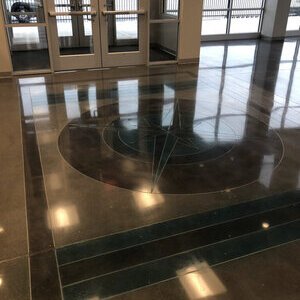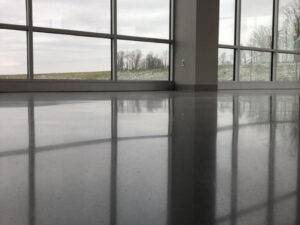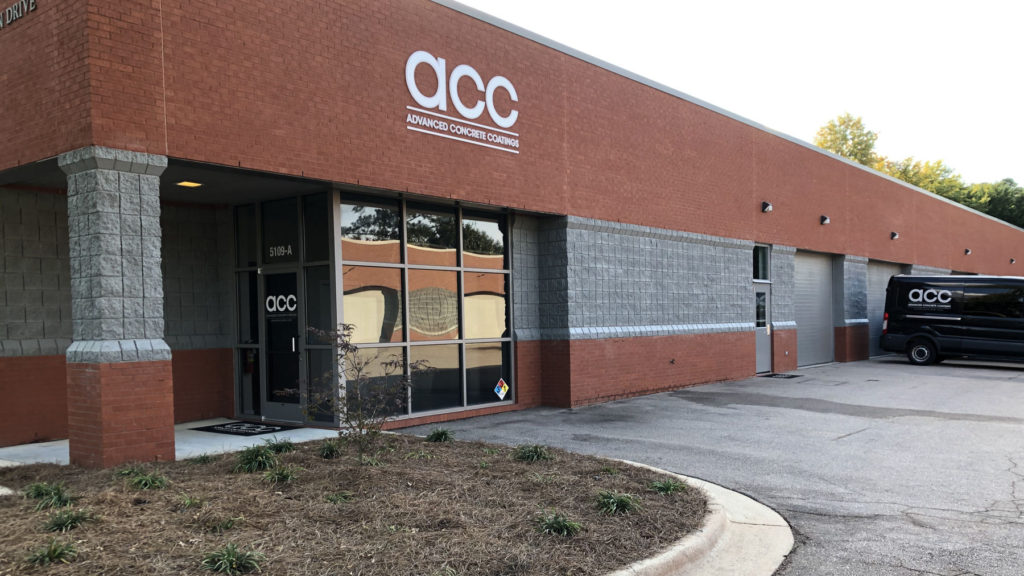Polished Concrete Floors
by Tom Cramsie
Polished concrete has become a popular flooring option due to its cost, low-maintenance, durability, and overall appearance.

Polished concrete has quickly become one of the most popular flooring options in recent years due to its low cost, durability, low-maintenance and natural beauty. Polished concrete can be installed anywhere there is existing concrete and offers an array of colors and design options.
Any structurally sound concrete can be polished. Diamond grinding equipment fitted with various grit diamonds is used to refine the concrete to the point that it closes the concrete pore space, producing a natural shine. Special diamond tooling can be used to remove adhesive and thin set from previously installed flooring. Solvent and water-based dyes can be used to add transparent color to the concrete, enhancing (not hiding) the natural characteristics of the concrete. Polyurea joint fillers are used to fill and seal control joints, alleviating dust and debris from collecting in them while creating a seamless floor. Epoxy-based grout coats are gaining traction as a means of filling small pinholes in the concrete that can result from course metal grinds. Chemical densifiers are used to harden and dustproof the concrete and are often applied after dye application to help lock-in the color. Penetrating and topical guards are often applied as a final step to aid in stain prevention.
Modern Polished Concrete Floors
Polished concrete floors offer a number of advantages over traditional floor coverings. Polished concrete floors offer superior scratch and abrasion resistance. Polished concrete will not be damaged in flood events. Polished concrete provides increased reflectivity which can result in energy savings. Polished concrete floors require less maintenance than traditional flooring such as carpet, tile or hardwood and have a much longer service life. Polished concrete does not require waxing, creating superior commercial concrete floor finishes.
Perhaps the biggest advantage of polished concrete floors is its durability. Ideal as industrial concrete flooring, polished concrete is excellent for high foot traffic areas, such as corridors and entrances. Because of this, polished concrete floors are being installed in schools, churches, retail and grocery settings and as commercial concrete flooring for big box stores worldwide. Polished concrete has even been gaining traction in residential settings although getting the large diamond grinding equipment into smaller areas is often not possible.
While extremely low-maintenance, polished concrete is not maintenance free (what is??). Frequent dust mopping and wet mopping is recommended. Citrus and pH neutral cleaners can be added to mop water if desired. For larger areas, auto scrubbing is the preferred maintenance method. Periodically, topical guards can be reapplied and burnished to revitalize the shine. Polished concrete floors are not stain proof; spills should be cleaned up as soon as possible to prevent staining.
Polished Concrete Floor Finishes
The smooth, reflective surface of polished concrete provides a canvas for an array of colors and decorative scoring options, creating bands, grids, borders, logos and other designs. Since polishing concrete is a multi-step process, the user can choose the level of sheen (satin to gloss) and desired level of aggregate exposure (large to fine). Deep, course grinds can be used to expose aggregate in the concrete while hybrid diamonds can be used to minimize aggregate exposure, creating a “cream” finish.
Polished concrete floors may look smooth as glass but are actually anti-slip, making them a preferred alternative for many commercial polished concrete floors. Most people associate “shiny” with “slippery” but that is not the case when it comes to polished concrete. In fact, polished concrete often has a coefficient of friction greater than waxed linoleum. Concrete is the most used building material in the world, found in some way or another in virtually all buildings. Making use of the existing concrete versus covering it with another flooring has far reaching environmental impacts. Additionally, concrete floors are often cool in the summer and warm in the winter which helps cut heating and cooling costs. As previously mentioned, the increased reflectivity allows for less lighting and reduced electric bills.
How To Polish Concrete
A typical polished concrete project will require the following items:
- Box truck with liftgate or trailer to transport equipment
- Moveable cart to house diamond tooling, hand tools and some sundries
- Large diamond grinding machines
- Vacuums for large diamond grinding machines (if dry grinding)
- Cordage (if electrically powered)
- Smaller vacuums for hand tools and floor cleaning
- Edging machine
- Variable speed hand grinders
- Joint saw (connected to a vacuum) to clean out control joints and profile the joint wall
- Polyurea joint filler pump
- Joint filler, chemical densifier and topical sealer
- High-speed buffer/burnisher fitted with a diamond impregnated pad
- Sprayers for dye, densifier and sealer
- Sundries – razor scrapers, rags, trash bags, tape, etc.
As you can see, there is a lot more to polished concrete than strapping on a tool belt and heading off to the job. It is not uncommon for concrete polishers to arrive at a job site with $100,000+ worth of equipment!!
Polishing concrete is a labor and equipment intensive process. For industrial polished concrete floors, most industrial diamond grinding equipment requires 3-phase 240v or 480v power. This equipment is either wired into house power (if sufficient) or ran off large generators. Some equipment makes use of propane powered engines that can be used indoors and alleviate the need for 3-phase power. The initial grinds are very slow (imagine walking at a snail’s pace) with each progressive grind getting faster. The final 800-grit or 1500-grit grinds are often done at a walking pace. The large walk behind diamond grinders will most often not grind all the way up against the wall. Specialized edges machines and variable speed hand grinders are used to polish the edges in order to blend in with the floor.
Despite the amount of equipment and time required to polish concrete, it is still one of the most affordable flooring options available. Typically priced in the $3-6/sf range, polished concrete consistently beats hardwood, ceramic tile and a lot of carpets when it comes to pricing. Pricing will largely be dependent on area size, amount of edging, dye application and any other decorative components.Polished concrete floors may not be perfect for an entire area but can have a role even when paired with carpet and tile. The cost, durability, low-maintenance and aesthetic value of polished concrete have led to its popularity and will lead to more increased use in coming years.
